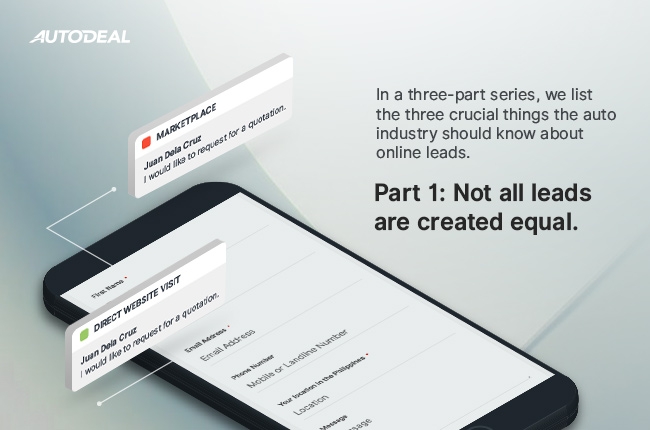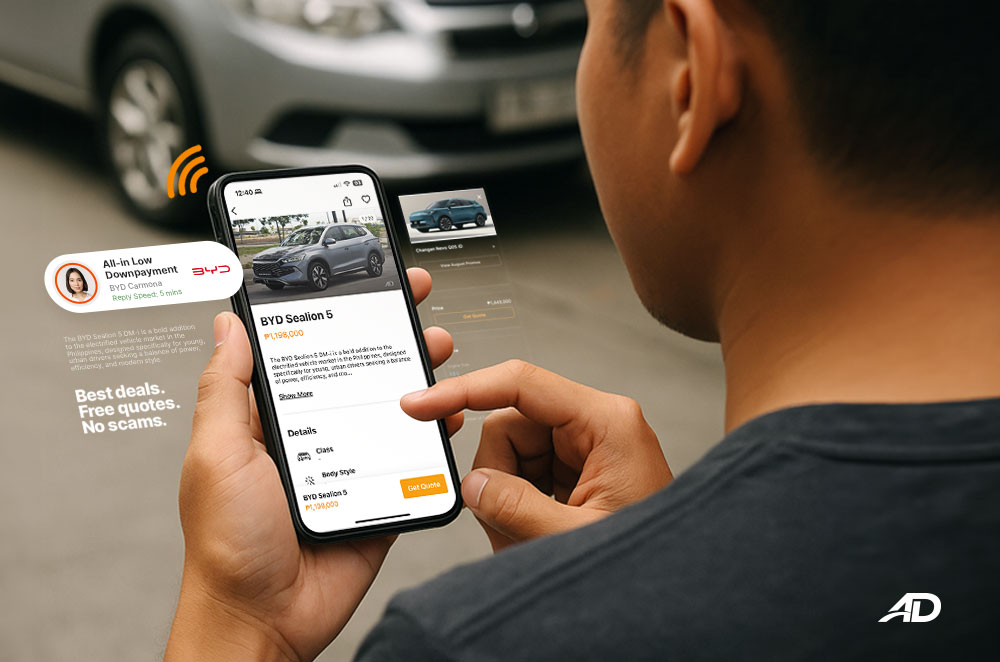
I find it prudent to be too early, rather than too late.
As local pioneers in the space of automotive lead generation, AutoDeal was subjected early on to a range of skepticism from critics who debated whether it was necessary for brands and dealers to engage in lead-generating activities amidst the sensational sales growth that was being achieved in the Philippine automotive industry from 2014 to 2017.
Fast forward four years, and I’d say we’re relatively thankful that we persevered through those difficult times. Over these years, online lead generation seems to be the new favored strategy among dealer, brand and agency marketers alike. Whether the result of natural marketing evolution, or a bi-product of tougher industry times, the result is positive not only for carmakers, but also for consumers who are now becoming more empowered before they reach the showroom.
As the local automotive industry transitions from digital campaigns that are solely focused on brand awareness to strategies that now aim to generate customers; many questions are being asked and many different approaches are being attempted. The benefit of working with fifteen (15) local brands across more than 350 car dealers, has enabled AutoDeal to deeply invest in truly understanding online lead generation and the many components that are required to target, attract and convert online prospects to real world sales.
Currently, my team and I receive a constant flow of questions from brands, agencies and dealers regarding our insights. With that said, in this series of articles, I am going to highlight three (3) of the most crucial things that all automotive brands and dealers need to know about when embarking on campaigns to generate online leads.
First of all: Not all leads are created equal.
When evaluating the sources of leads, marketers are often attracted to platforms offering an incredibly low cost per-lead rate. While compelling on the surface, the reality of working with a high volume of low cost leads is more challenging than what marketers may first anticipate; and a source of serious friction between sales and marketing teams. The simple truth is that more leads means more work for your sales teams and an increased investment in human capital.
Why? Well generally speaking, the higher the cost per lead, the higher quality and more ready to buy the consumer should be. In contrast, if the leads are cheap, then you can anticipate lower quality contacts and a longer lead-to-sale conversion timeline. In our experience, this long conversion timeline is what often leads to poor lead retention and low sales conversion, quite simply because brands and dealers do not yet have the means to manage prospects over extended periods of time.
Believe me, we study factors like lead-to-sale conversion timelines with a great degree of focus, namely through our ability to track completed transactions across our partner network. In the chart below, you will see the difference in lead-to-sale conversion timelines for AutoDeal generated vehicle sales in 2018 based on their referring traffic source.

In comparison, if leads were priced higher, then they should be more qualified and ready to buy within a shorter time frame. Balancing the economics of this equation will involve careful planning and constant evaluation from marketers, especially with regards to analyzing available manpower and technical capability. This will eventually help brands to transition from a less efficient cost-per-lead strategy to a greater ROI generating cost-per-sale metric.
So, let’s take a look at each channel in a little more depth and see how they differ.
Social
Generally, when I look at lead-sources, I typically take the lead-value pyramid into consideration (see diagram below). Each layer represents a specific macro-level strategy that encompasses lead volumes and lead-to-sale conversion rates. As the layers stack up, the volume of leads that the strategy provides becomes less, but their lead-to-sale conversion improves.

In terms of vehicle purchasing, we find that a social platform is able to generate a high volume of leads but by comparison a much lower conversion rate than other strategies within a standard zero to six month buying cycle. While leads generated from social platforms can certainly generate volume sales, it is important that brands be aware of the cost associated in nurturing these high funnel leads. The hypothesis behind this is relatively simple; users accessing social media websites like Facebook and Twitter are not actively shopping for vehicles, and as such not in the same mindset as the users of other digital services.
With that said, social media is still an unparalleled medium to reach your overall target market, and as such marketers cannot ignore the value that it brings to generating customers over a long period of time.
So what can automotive brands expect? Currently at AutoDeal, only 8.41% of sales generated on our platform originate from a referral click through made via Facebook. Likewise the average lead-to-sale conversion rate is only 0.36%; most likely because the average lead-to-sale conversion time far extends past the capability for most dealers to not only manage, but to successfully track to sale.
Note: Social media channels, especially Facebook, have a wide-range of marketing tools available for automotive brands. Attracting users to inquire via your Facebook page should still be encouraged, as the results should in many ways have similar results to what you can ascertain from those customers who go direct to your website (more on that below).

Search Engine
Moving up, we can see that ads on Search Engines will yield lesser volumes, but a higher conversion rate than social. Unlike social ads which typical targets are based on market demographics, the ads on search engines like Google will require marketers to be selective on keywords.
Optimized keyword selection may further alter the lead volume and lead-to-sale conversion rate generated through ads. Nevertheless, since ads will often drive users to your own URL, marketers should be attentive to the onsite performance of their own website in order to truly maximize results. This means, close attention to how easy it is for users to navigate, inquire and purchase from your website.
The ace for search engines is that, unlike the social channels, these target users who are specifically looking for something, and as a result, marketers can get creative in the way in which they attract these users to their brand. While much more clinical and less sexy than social, the search engines are valuable and irreplaceable components of any digital marketing strategy. Ask any expert, and they’re likely to tell you the same thing.
The search engine is an unparalleled channel because of the “intent” involved whenever your target market uses it. It fulfills the users’ needs searching for something—a channel that satisfies users’ searches or that of the queries before the queries. It is a demand-fulfillment medium that drives users down the consideration and the purchase stages of the buying funnel.
When it comes to Google, it’s not just ads that you should be paying attention to. Viray further states, “To maximize the search channel for lead generation, you should consider both paid and organic — utilizing Google’s display, search ads, and SEO.”

Marketplaces
Unlike social media and search engines, the online marketplaces often provide detailed information, advanced online shopping tools and accompanying services which are designed to better empower and inform consumers.
This is the beauty of online marketplaces, and the reason that many automotive marketers around the world are encompassing this medium into their overall digital strategy.
Mark Harland, executive director of GM Holden in Australia points out that the traditional methodology of conducting research and inquiring information at the dealership is changing in favor of a different consumer journey powered through online marketplaces.
“This has changed quite dramatically, all that shopping and research that used to happen in dealerships happens online,” Harland points out. “They know the dealership where they're going to purchase it from and they've pretty much done most of that work and are armed with an awful lot of information through digital and social channels.”
Globally, the automotive industry is inundated with marketplaces like AutoTrader.co.uk, AutoTrader.com and CarSales.com.au that dominate established western markets. While the likes of CarDekho (India), WebMotors (Brazil) and CarList (Malaysia) established themselves in emerging and frontier markets.
It’s not difficult to understand why automotive brands in a country like Australia favor matured and dominant marketplaces like CarSales.com.au (which was founded in 1996) that has already made its mark as the go-to place when shopping for a car. Aside from this, marketplaces tend to have several other advantages such as well-established SEO that comes as a result of ongoing investments in technical infrastructure and content creation. Brands and dealers can then advertise, on the back of the marketplaces popularity, as a means to increase their discoverability.
“We aim to be where the fish are fishing, those big auto classifieds sites,” states Ally Cooney, head of Toyota Australia’s media agency The Media Store.
While marketplaces might not provide the same volume of leads as the likes of social and search; they do provide prospects with a much higher intent-to-buy. What brands need to take into consideration (as with all their leads), is that customers shopping on an online marketplace might not only have interest in them, but also in their competitors. We’ll cover more about this in Part 3.

Direct Website Visits
Sitting atop of the pyramid is direct visits to your brand or dealer website. Direct traffic tends to be a bi-product of all other marketing strategies that you’ve engaged in. While direct traffic might not generate a high-volume of leads, it does generate leads from consumers who know and want to engage with your brand. The result is a much higher lead-to-sale conversion.
Despite the differences, all of these lead generation activities maintain their own unique advantages and disadvantages. What brands need to keep in mind, are the following:
1. Resources: How many leads are you generating? How many sales consultants does it require to manage them all?
2. Tracking & Timing: How do you keep in contact with prospects over time? What is your expected lead-to-sale conversion timeline for each lead source?
Above all else, brands also need to be considerate on how to meet customer expectations, a topic which we’ll discuss more in Part 2.




